Water scarcity report - 07 August 2025
The Deveron, Ythan, Don (Aberdeenshire), Esk, Firth of Tay and Tyne catchments remain at Moderate Water Scarcity.
The Findhorn, Spey, Dee (Aberdeenshire) and Firth of Forth catchments remain at Alert.
The rest of the country remains at Early Warning or Normal conditions.
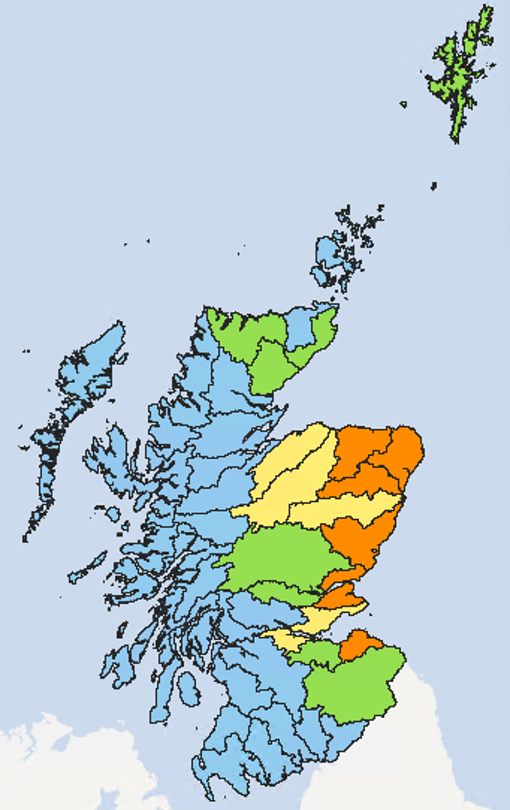
Situation summary
Over the last week, there has been heavy rain in the west associated with Storm Floris, with some heavy showers elsewhere. However, the heaviest rain fell in places not currently affected by water scarcity.
This rain was sufficient to promote recovery in Thurso, Orkney and the Outer Hebrides from Early Warning to Normal Conditions. There are no changes elsewhere.
Overall, July saw rainfall that was around average to below average. In eastern areas, much of this rain fell during one intense day. For example, at Baluniefield in Dundee, over half of the month’s rainfall was recorded in one day. This heavy rain caused river levels to rise quickly. However, much of the water didn’t soak into the ground, so it didn’t help replenish groundwater. As a result, groundwater levels at many of our monitoring sites in Fife were the lowest ever recorded for July (following the dry autumn, winter and spring). This leaves rivers more vulnerable if dry weather continues.
What do the map colours mean?
| Normal conditions | Early warning | Alert | Moderate scarcity | Significant scarcity |
|---|---|---|---|---|
| Blue | Green | Yellow | Orange | Red |
Water scarcity area descriptions
Weather Forecast
Showers or longer spells of rain will develop across the northwest and Northern Isles on Friday, mainly dry elsewhere. A weakening band of rain will move southeast on Saturday, but light and patchy in the east. Further rain will spread northeast to most of Scotland later on Sunday, dying out Monday.
Advice for water users
We advise water users, including those with private water supplies, to be aware of the potential risk of water scarcity this summer, and for businesses to plan ahead where possible. Advice for abstractors and irrigators.
Supporting information
This section goes into more detail on the data behind the water scarcity levels.
Rainfall and river flows
These maps show rainfall and river flows relative to the long-term average, for this time of year, over 1 month, 3 months, and 6 months.
The last month of rainfall shows mostly normal conditions across Scotland. Wet conditions are present locally to the north of the great glen, while quite dry conditions are observed in some parts of the Outer Hebrides, the northeast and the central belt. River flows over the past 30 days continue to display an east to west split across Scotland, with eastern areas seeing low to very low flows, and western areas and the Northern Isles generally showing normal conditions.
Rainfall over the last three months shows a slight east to west split across the country. Western Scotland is mostly normal to very wet, while parts of the east remain quite dry to very dry. River flows for the last three months remain very low to extremely low in the east, while the rest of the country generally shows normal to very high flows.
Over the past six months, rainfall conditions have been mostly dry to extremely dry in the east and south of Scotland, with generally normal to dry conditions in the northwest of the country. River flows across much of the country remain very low to extremely low for the past six months, although the Hebrides, Shetland and west Scotland show normal to dry flows.


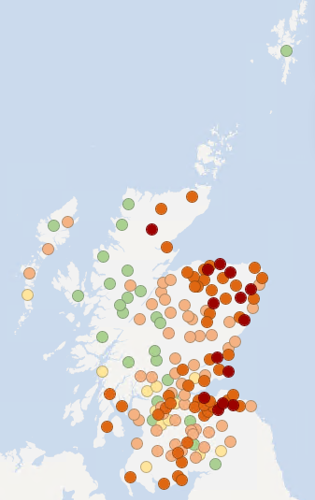
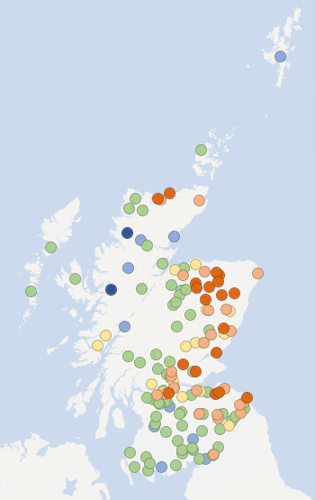
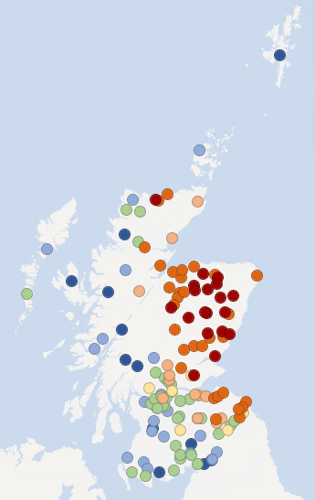
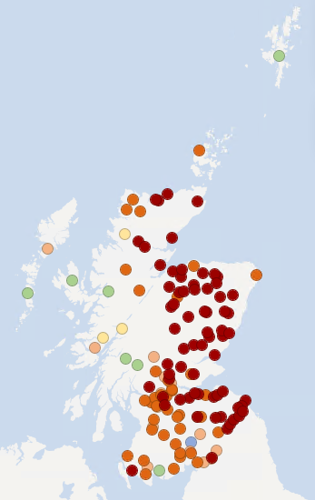
What do the map colours mean?
| Rainfall | Extremely dry | Very dry | Dry | Quite dry | Normal conditions | Wet | Very wet |
|---|---|---|---|---|---|---|---|
| River flow | Extremely low | Very low | Low | Quite low | Normal conditions | High | Very high |
| Red | Orange | Light orange | Yellow | Green | Light blue | Dark blue |
Soil moisture deficit
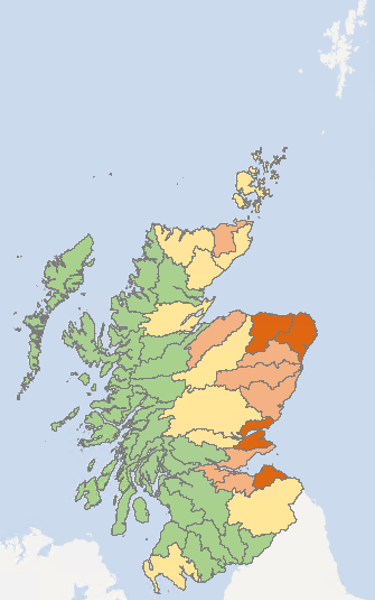
This map shows this week’s soil moisture deficit. This is obtained from the Met Office Rainfall and Evaporation Calculation System (MORECS). Ground conditions across the east are quite dry to extremely dry. In the west, though, there is generally no deficit.
What do the map colours mean?
| Extremely dry | Very dry | Dry | Quite dry | No deficit |
|---|---|---|---|---|
| Red | Orange | Light orange | Yellow | Green |
Natural water storage – groundwater and loch levels
In each river catchment there is some degree of natural water storage, which can maintain river flows even when it is not raining. This natural water storage is mainly held in lochs and groundwater. When storage has been depleted it will take a lot of rainfall for levels to recover.
The maps below show recent groundwater and loch level compared to the long-term record at each individual station. Level is reported as high or low compared to the typical (‘normal’) level range for the time of year.
Level ranges are specific to each station and based on the long-term (minimum 10 years) record of mean monthly level values recorded at individual stations.
Despite the recent rainfall, due to the lack of recharge over the autumn and winter, groundwater levels across most of the country remain low to very low for the time of year.
Locations in Fife have recorded their lowest levels for July on record. In its 28-year record the Newton of Falkland borehole has only recorded levels this low once before, in July to October 2006, and Scotlandwell recorded its lowest July level in its 27-year record. Boreholes in the Ythan catchment in Aberdeenshire are also close to or at the lowest levels previously seen in July.
Without significant rainfall, groundwater levels are expected to continue to fall over the summer.
July average loch levels are low in the northeast of Scotland with levels elsewhere between normal and very high.
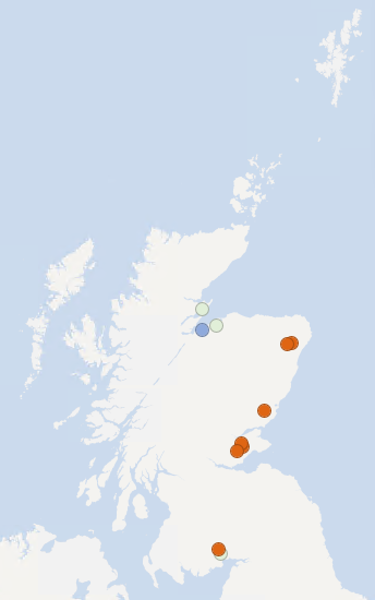
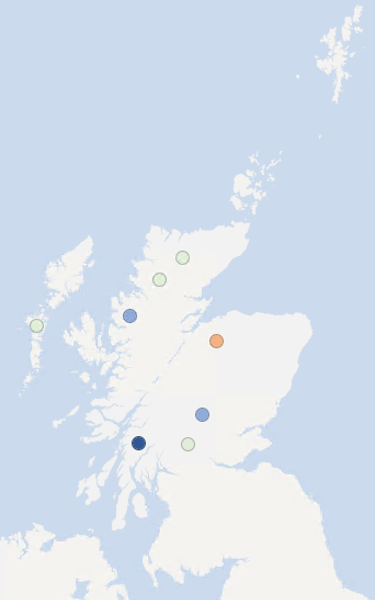
What do the map colours mean?
| Very high | High | Normal range | Low | Very low |
|---|---|---|---|---|
| Dark blue | Light blue | Light green | Light orange | Dark orange |
Flow, rainfall and groundwater data are accessed via SEPA's time series data service (API). SEPA's live data are subject to ongoing quality control and periodic review.
Scottish Water are responsible for public water supply and distribution in Scotland. Scottish Water reports on the raw water stored in these supplies.
Report copyright
- Current water scarcity levels - © SEPA. Some features of this information are based on digital spatial data licensed from the Centre for Ecology and Hydrology © NERC (CEH). Contains OS data © Crown copyright (and database right).
- Areas of significant water scarcity - OS Data - © Crown Copyright - SEPA licence number 100016991 (2022)
- Rainfall, river flow, groundwater and loch levels - Base map © OpenStreetMap contributors.
- Soil moisture deficit - Data based on MORECS (Met Office © Crown Copyright). Some features of this information are based on digital spatial data licensed from the Centre for Ecology and Hydrology © NERC (CEH). Contains OS data © Crown copyright (and database right). Base map © OpenStreetMap contributors.
- Weather forecast - Crown copyright [2022], Met Office
